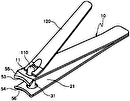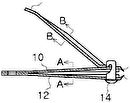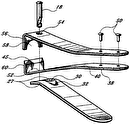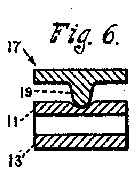
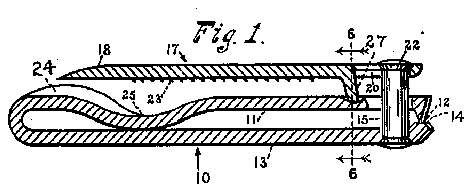
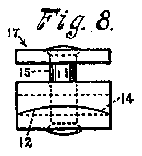
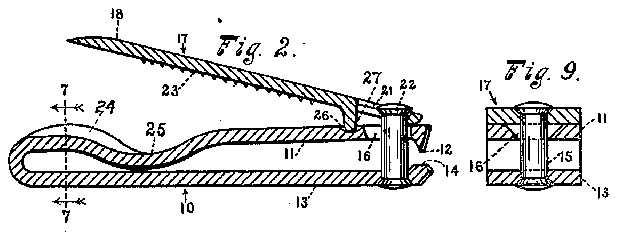
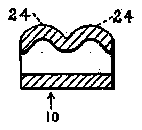


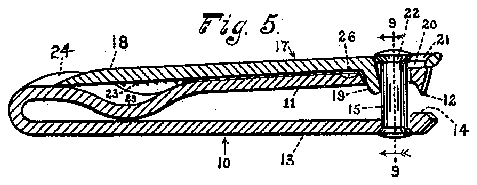
- 3jaw members may be moved
- 6line
- 10aws member
- 11member
- 12cutting edge
- 13members
- 14supporting face
- 15pin
- 16opening
- 17member
- 18portion
- 19projection
- 20slot
- 21upper portion
- 22conical head
- 23nail filing surface
- 24projections
- 25depressed portion
- 26recess
- 27face
Description
H. LA GASSE.
MANIGURING DEVICE.
APPLICATION FILED 1320.16, 1912.
1,085,569. Patented Jana?, 1914.
Ik F15. 6. l m '7X/715,1, zz- ,K F156.
IS-- l5" l-I ,l2 f l '-14 '.ii. "H
,l ll/l//l//l/l//l/I//l//l/l//l/l/l/// l um la' fm. man
COLUMBIA PMNOGRAPH Co.,W^sH|NnToN, D. c.
HENRY LA CASSE, 0F LOS ANGEL-ES, CALIFORNIA.
MANICURING DEVICE.
Specification of Letters Patent.
Patented Jan. 27, 1914.
Application led December 16, 1912. Serial No. 737,121.
To all lwhom it may conc-cm:
Be it known that I, HENRY LA Cassia, a citizen of the Unit-ed States of America, residing at Los Angeles, in the county of Los Angeles, State of California, have invented a certain new and useful Manicuring Device; and I do hereby declare the following to be a full, clear, and exact description of the invention, such as will enable others skilled in the art to which it appertains to make and use the same.
This invention relates to improved manicuring device, and it may be said to consist in the provision of novel and advantageous features and in the novel and improved construction, arrangement and combination of parts as will be apparent from the description and claims which follow hereinafter.
One object of the invention is to provide a manicuring device made up of a comparatively small number of parts, and adapted for use to clip, clean, and file finger nails.
Further objects of the invention are to provide an improved manicuring device which is simple in construction, economical to manufacture, strong and durable, easily compacted to occupy a small space, of a neat appearance, effective in action, a-nd which may be carried about without injury to the clothes or person of the user.
Other objects and the advantages of the invention will be apparent to those skilled in the art from a consideration of the following description of one form of device einbodying the invention, taken in connection with the accompanying drawings in which- Figure 1 is a central longitudinal sectional view of the. device with the cutting edge and supporting-face moved together; Fig. 2 is a similar view with the cutting edge and supporting face spaced from each other; Fig. 3 is an enlarged plan view of the device with the pivoted member moved to project forwardly of the jaws member; Fig. 4 is a longitudinal sectional view taken centrally of Fig. 3; Fig. 5 is a central longitudinal sectional view of the device with the pivoted member moved to lowered position on the jaws member; Fig. 6 is a cross-sectional view taken on the line 6 6 of Fig. 1; Fig. 7 is a cross-sectional view taken on the line 7-7 of Fig. 2; Fig. 8 is a front end elevation of the parts in Fig. 1, and Fig. 9 is a cross-sectional view taken on the line 9-9 of Fig. 5.
The integral aws member 10, of resilient material, is formed to provide the upper jaw member 11 having at the forward end thereof the cutting edge 12 which is curved upwardly and rearwardly from the sides thereof, and the lower jaw-member 13 having at the forward end thereof the supporting face 14 which is curved upwardly from opposite sides there-of and extends a short distance forwardly of the cutting edge 12 to prevent too close-cutting of the finger nails in practice.
Near the forward end of the member 13 is suitably secured the lower end of a pin 15 Vwhich passes upwardly through an opening 16 in the forward end portion of the member 11; the length of the opening 16 preferably Aheilig' greater than the diameter of the pin 15 andthe upper portion 16 of the opening 16 being of gradually increased width.
Above the member 11 is pivotally and slidably mounted on the pin 15 the member 17 which has one end portion 18 thereof suitably formed for cleaning finger nails, and wh1ch has the downwardly and forwardly `extending projection 19 pressed out therefrom at the other end portion thereof thus forming the slot 20 which latter is of greater length than the diameter of the pin 15 and the upper portion 21 of which is preferably vcountersunk to accommodate the conical head 22 of the pin 15.
The underside of the member 17 may be formed with a nail filing surface 23.
At its rear the member 11 has formed thereon the spaced projections 24 which serve to hold therebetween and guard the pointed portion 18 of the member 17 when the parts of the device are in compacted or disuse condition, and it is formed forwardly of the projections 24 with a depressed portion 25 which facilitates taking hold of the member 17 to move it away from the jaws device 10, affords a good finger hold on the jaws device 10 when the device is manipulated, and may be used to eHect contact between the members 11 and 13 at a point intermediate their ends to attain greater effectiveness in action when the members 11 and 13 are moved together in operation.
The member 17 may be pulled upwardly and rearwardly on the pin 15 from the position shown in Fig. 5 to have the end of the projection 19 disposed on the upper surface of the aws member 10 in the recess 26 adj acent to the rear of the opening 16, 16', see
Fig. 2, whereupon t-he member 17 may 'be pressed downwardly to move together the members 11 and 13, see Fig. 1, to have the cutting edge 12 clip finger nails placed against the supporting face 14. By pushing the member 17 forwardly from the position shown in Fig. 2 the 'projection 19 may be made to enter the rear of the opening 16 to compact the parts as'seen in Fig. 5. Again, the member 17 may be swung from the position shown in Fig. 2 and pulled upwardly and swung from the position shownl in Fig. 5 and pulled to have it extending forwardly of the jaws member 10, see Figs. 3 and 4. lVith the face 27 of the projection 19 in contact with the Jfront edge of the member 11, the member 17 is steadied in position for use to clean or file finger nails. From the position shown in Figs. 3 and 4 the member 17 may be easily and quickly moved' to either of the positions shown in Figs. 2 and Vhile one form of construction embodying the invention has been particularly illustrated and described, there are many changesand modifications thereof that will readily occur to those skilled in the art, wherefore, the right is reserved to all such changes and modifications as do not depart from the spirit and scope of the invention as defined in the appended claims.
I claim:
1. A manicuring device, comprising jaw members of resilient material, one of said jaw members provided with an opening` therethrough, a pin secured to the other of the jaw members and passing through said opening, said opening ot' greater length than the diameter of the pin, a cutting edge on one of the jaw members and a supporting face on the other of the jaw members, and a member having one end portion thereof formed with a slot and pivotally and slidably mounted on the pin and provided with a projection normally fitted in said opening, said slot being of sufficient length to permit said member being moved to dispose said projection either in said opening, or on the upper surface of one of the jaw members so that both of the aw members may be moved together by pressure exerted on said member, or to contact with the front edge of one of the jaw members to steady the member in position thereon, substantially as described.
2. A manicuring device, comprising jaw members of resilient material, one of said jaw members provided with an opening therethrough, a pin secured to the other of the jaw members and passing through the opening, said opening of greater length than the diameter of the pin, a cutting edge on one of the jaw members and a supporting yface on the other of the jaw members, a
member having one end portion thereof 'formed' with a slot and pivotally and slidv ably mounted on the pin and provided with a projection normally fit-ted in said opening, said slot being of sufiicient length to permit said member bein-g moved to dispose said projection either in said opening, or on the upper surface of one of the jaw members so that both of the jaw members may be moved 3. A manicuring device, comprising jaw imembers of resilient material, one of saidfr ljaw members provided with an opening i therethrough and having spaced projections fthereon and a depression forwardly of the projections, a pin secured to the other of the jaw members and passing through the opening, saidopening of greater length than the diameter of the pin, a cutting edge on one f of the aw members and a supporting tace on either in said opening, or `on the upper surface of one of the jaw members so that both of the jaw members may be moved together by pressure exerted on said member, or in cont-act with the front edge of'. one of the jaw members to steady the member in position thereon, substantially as described.
In testimony whereof, 1 have signed my vname to this specification in the presence of two subscribing witnesses at Los Angeles, county of Los Angeles, State of California, this 11th day of December, A. D. 1912.
HENRY LA CASSE. Witnesses FRED A. MANsrIELD, A. H. LIDDERS.
Copies of this patent may be obtained for ve cents each, by addressing the Commissioner of Patents.
Washington, D. G.
